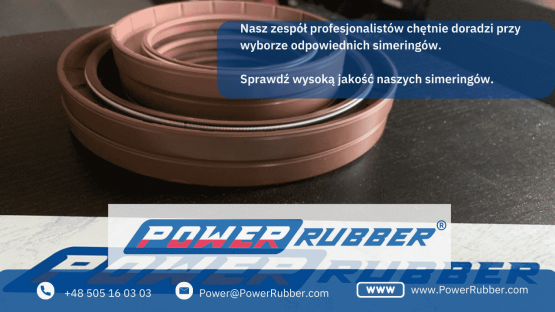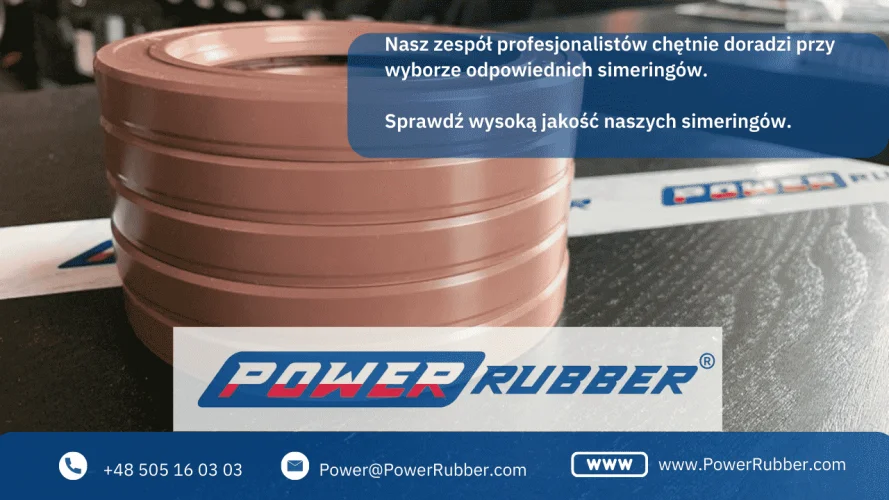What is a Simmering? How to Use Shaft Seals? Complete Guide
Sealing rings of the Simmering type (also known as Simmer rings) protect components of machines and devices in which rotary motion is transmitted. The Simmering seal protects these components from leaks of oils and greases, as well as prevents moisture and contaminants from the outside (dirt, dust, mud) from entering.

Construction of sealing rings
The main elements of radial seals (simmerings) include:
- metal stiffening insert (provides stability)
- outer coating made of elastomer or steel sheet
- sealing lip with or without a spring
Rotary seals can only be used for a relative peripheral speed of the shaft journal surface not exceeding 5 m/s.
Types of Simmerings
Some Simmerings differ in construction, so we divide them into classes:
They may have additional markings indicating construction details, e.g.:
- S/ST/O indicate that the product is equipped with an additional dust lip.
- WxO/ZV are used in the case of a seal built with a sealing lip without a compression spring.
- H indicates a pressure-type simmering.
- E/D/DUO indicates a product with two sealing lips.
Simmering A
The Simmering A type seal consists of an elastomeric outer shell, a metal stiffening insert, and a sealing lip with a compression spring. The compression spring ensures tightness at the contact point with the shaft. The Simmering effectively seals parts of devices (shafts, hubs) moving in rotary or torsional motion. It does not have an additional dust lip.
Simmering AO
Simmering AO type is a double-lip sealing ring used at overpressures up to 0.3 MPa. It consists of an outer surface coated with elastomer, a sealing lip with a spring, and an additional dust lip. The additional lip serves as protection against dust, chips, and dirt. The use of a dust lip allows the product to be used in systems with increased pressure and significantly extends the service life of machines and devices. Its design is perfectly suited for sealing thin-layer and gaseous media. It effectively protects against any contamination from the outside. It is used in construction and agricultural machinery, mechanical engineering and apparatus, as well as in drive systems, electric motors, and industrial gearboxes.
Simmering B
Simmering B is a single-lip seal made of rubber reinforced with a metal ring. The outer coating is not covered with elastomer. It is used in power transmission systems. It is not recommended for devices requiring gas retention.
Simmering BO
Simmering BO is a type of seal made of a sealing lip without a compression spring and a metal insert without a protective coating. It works very well in applications where protection against water or dust ingress is important.
Simmering C
Simmering class C is characterized by additional reinforcements. It is made with a reinforcing insert without an elastomer protective coating. Designed for use in large machines. It works perfectly in harsh conditions with high dust levels.

Simmering sealing rings – radial shaft seal
Rotary seals provide a perfect fit between rotating components and static components of machines. Their purpose is to prevent any leakage of the lubricating medium, limit pressure, and prevent moisture, dirt, and dust from entering from the outside. Simmerings are most commonly used in drive systems, axles, construction and agricultural machinery, gearmotors, apparatus, compressors, mixers, and robotics. They are used in, among others:
- wind turbine generators
- household appliances (washing machines, dishwashers)
- industrial gearboxes
- pumps
- electric motors
Discover the most important benefits of using Simmerings:
- increased service life of individual machine parts (protection against wear)
- high sealing performance in high-pressure systems
- effective protection against leakage of lubricating substances
- high protection against contamination from the outside
Which Simmering to choose?
Before purchase, it is worth paying attention to several important issues to ensure the Simmering fulfills its function:
- type of sealed medium
- operating environment temperature
- seal resistance to operating pressure
- dimensions of the Simmering and shaft
- direction of operation and shaft rotational speed
Simmering – installation and replacement of the crankshaft seal
Simmerings are rotary sealing rings installed in devices to retain the lubricant. They provide tight and reliable operation, are easy to install, and also extend the service life of machines and their components.
The rotary shaft seal (simmering) consists of a dynamic part in the form of a sealing lip with or without a compression spring, made of elastomer, a metal stiffening insert, and an outer coating made of rubber or steel sheet.
Some simmerings are double-lipped. They have an additional dust lip. The additional dust lip protects machines and components from contaminants (dirt, dust, chips, mud) and moisture entering inside.
If you want to know how to replace worn or damaged Simmer rings, how to properly seat a new sealing ring, and why you should use a suitable layer of grease before installation, read the article below.
How to remove a Simmering?
Engines, gearboxes, or other components in which shafts are the moving elements require sealing with simmerings. Radial seals at the point of contact with the shaft surface may suffer mechanical damage, e.g., due to wear. It is important to replace old or worn Simmer rings with new ones. This is the best way to ensure effective sealing and trouble-free operation of machines and devices.
So how to remove a Simmering? First, check if there is access from the outside to the element on which the Simmer ring is seated. Then you need two hooks for pulling simmerings (no wider than the width of the ring, they can be made from wire), which must be pressed along the shaft. After hooking onto the rear wall of the ring, use flat pliers to pull them. The simmering seal should slide out with slight resistance. A special puller can also be used to remove the radial seal. During disassembly, be especially careful not to damage the walls of the hole in which the seal was seated.
How to correctly install (seat) a Simmering?
-
Using hooks with catches, a puller, or a flat screwdriver, remove the old seal.
-
Before installation, check the crankshaft for scratches or deformations on its surface.
-
Using a cloth, remove all contaminants from the surface of the shaft.
-
Prepare a special tool for installing simmerings or a plastic sleeve (e.g., from a cup wall) and lubricate it with oil (this will make the seal slide without resistance).
-
Ensure the radial seal has no cracks, cuts, or any defects.
-
Seat the simmering in the correct place.
Important! The seal must not be hammered onto the shaft, as it may become damaged.
Should a Simmering be lubricated before installation?
To make it easier to install the simmering in the correct place, it is worth applying a thin layer of grease before installation. Only the surfaces in contact with the housing and the shaft are lubricated. Grease additionally improves the tightness of the connection and extends its service life. Simmer rings with a sealing lip with a spring cannot operate dry. During installation, handle the seal carefully, as any damage will result in leakage. At Power Rubber, we have special grease for simmerings.
Rubber compounds for the production of simmerings
The rotary motion seal is most often made from various materials, such as:
Nitrile rubber
A Simmering made of NBR rubber is resistant to mineral oils and greases, vegetable and animal oils, aliphatic hydrocarbons, as well as non-flammable hydraulic fluids (HSA, HSB).
Fluoroelastomer FKM - FPM
A Simmering made of FKM/FPM rubber is used in many industries. Fluoroelastomer is characterized by high strength and resistance to mechanical damage. It is resistant to mineral oils and greases (also with additives), aromatic and aliphatic hydrocarbons, and fire-resistant hydraulic fluids (HSC).
Silicone rubber
A Simmering made of VMQ rubber guarantees resistance to mineral oils and greases, aliphatic and aromatic hydrocarbons (toluene, xylene), diluted salt solutions, ozone, and conditionally to non-flammable hydraulic fluids HSD. It is perfect for working in environments with a wide temperature range. The choice of the appropriate material from which the Simmering is made depends on the working environment.
Why does the crankshaft seal leak after replacement?
The primary function of the crankshaft seal is to prevent oil leaks. Check why a new simmering may leak – here are the reasons:
Incorrectly selected type and size of simmering
The typical design of a radial seal consists of three main elements: a metal insert, a sealing lip with or without a compression spring, and an outer coating made of elastomer or steel sheet. The size selection should take into account the appropriate outer and inner diameters. Several types of simmerings are available on the market, e.g., type AO with an additional dust lip that prevents dirt, dust, chips, and moisture from entering inside, or a simmering with a compression spring that additionally provides a hermetic barrier against oil leaks.
Incorrect selection of the material from which the Simmer ring is made
The choice of material from which the simmering is made should take into account the working environment. For example, if the crankshaft seal is made of material operating in a low-temperature range, wear and degradation of the seal will be caused by excessive heat exposure.
Deformations or damage to the crankshaft surface
The Simmering acts as a hermetic barrier against leaks of the lubricating medium. If oil leaks from a new seal, it is worth checking whether the crankshaft surface has been mechanically damaged, e.g., during servicing at a car workshop. The cause may also be the wear of the shaft itself, which can lead to loosening of the seal. Even small leaks can cause excessive wear and lead to complete failure of individual components (e.g., damage to the engine, gearbox, oil contamination of the clutch or flywheel).
Contamination of the crankshaft surface or simmering
Seal damage may be caused by contaminants or foreign bodies from around the shaft or the Simmer ring itself. Before installation, remove all dirt with a cloth.
Damaged simmering housing
A deformed, cracked, or cut simmering housing can be another reason for oil leakage from the engine. It is very important not to hammer the seal onto the shaft during installation, as this can damage it and consequently cause mixing of air and oil, resulting in leakage. Always check the condition of the seal before installation.
Installing a simmering without using grease
Before installing a new simmering, it is worth applying a thin layer of grease to it. The use of grease facilitates installation of the seal, improves tightness, and extends its service life.
We offer Simmerings made of high-quality materials. Thanks to our wide range of products, you can find everything you need in one place. Contact us. Contact form
